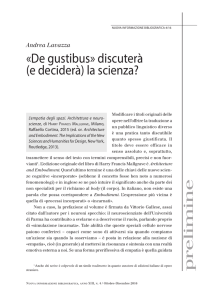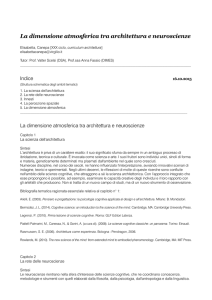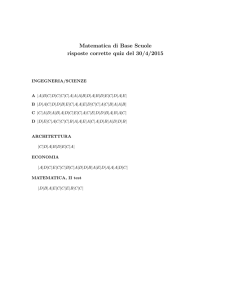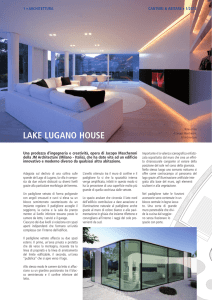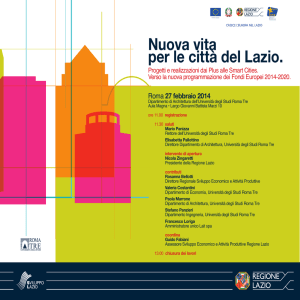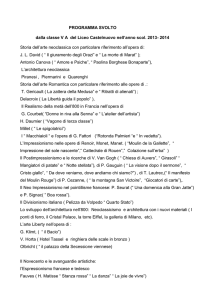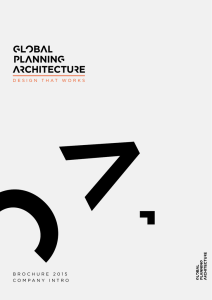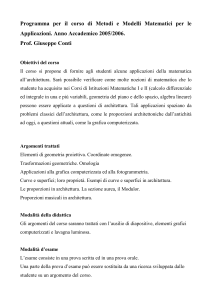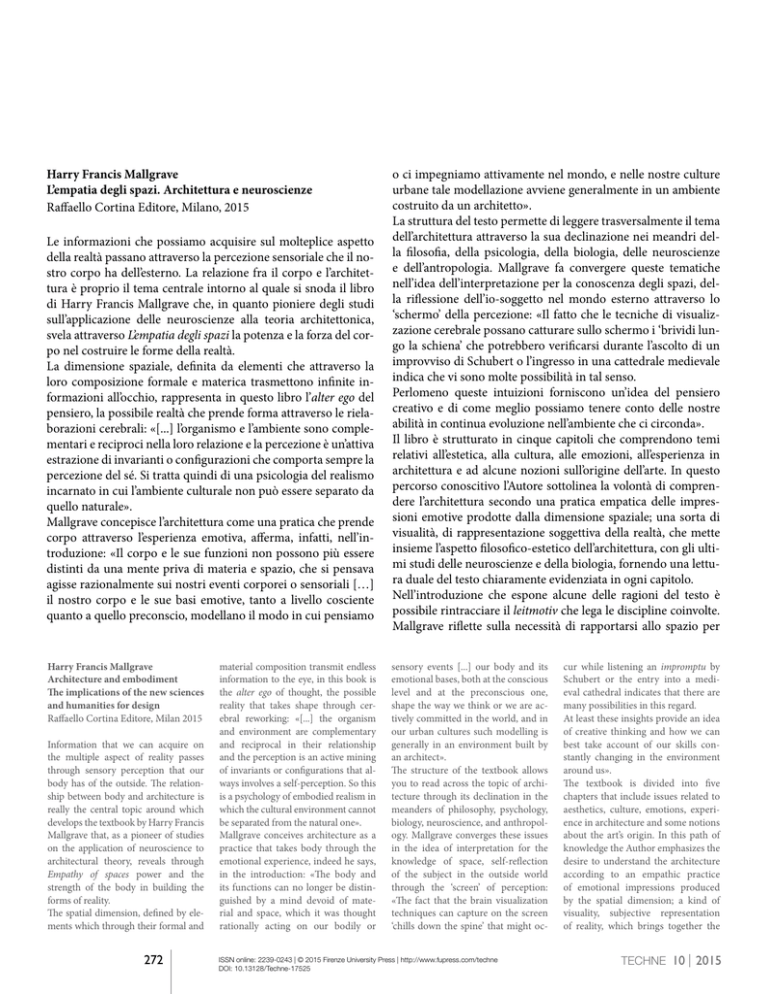
Harry Francis Mallgrave
L’empatia degli spazi. Architettura e neuroscienze
Raffaello Cortina Editore, Milano, 2015
Le informazioni che possiamo acquisire sul molteplice aspetto
della realtà passano attraverso la percezione sensoriale che il nostro corpo ha dell’esterno. La relazione fra il corpo e l’architettura è proprio il tema centrale intorno al quale si snoda il libro
di Harry Francis Mallgrave che, in quanto pioniere degli studi
sull’applicazione delle neuroscienze alla teoria architettonica,
svela attraverso L’empatia degli spazi la potenza e la forza del corpo nel costruire le forme della realtà.
La dimensione spaziale, definita da elementi che attraverso la
loro composizione formale e materica trasmettono infinite informazioni all’occhio, rappresenta in questo libro l’alter ego del
pensiero, la possibile realtà che prende forma attraverso le rielaborazioni cerebrali: «[...] l’organismo e l’ambiente sono complementari e reciproci nella loro relazione e la percezione è un’attiva
estrazione di invarianti o configurazioni che comporta sempre la
percezione del sé. Si tratta quindi di una psicologia del realismo
incarnato in cui l’ambiente culturale non può essere separato da
quello naturale».
Mallgrave concepisce l’architettura come una pratica che prende
corpo attraverso l’esperienza emotiva, afferma, infatti, nell’introduzione: «Il corpo e le sue funzioni non possono più essere
distinti da una mente priva di materia e spazio, che si pensava
agisse razionalmente sui nostri eventi corporei o sensoriali […]
il nostro corpo e le sue basi emotive, tanto a livello cosciente
quanto a quello preconscio, modellano il modo in cui pensiamo
Harry Francis Mallgrave
Architecture and embodiment
The implications of the new sciences
and humanities for design
Raffaello Cortina Editore, Milan 2015
Information that we can acquire on
the multiple aspect of reality passes
through sensory perception that our
body has of the outside. The relationship between body and architecture is
really the central topic around which
develops the textbook by Harry Francis
Mallgrave that, as a pioneer of studies
on the application of neuroscience to
architectural theory, reveals through
Empathy of spaces power and the
strength of the body in building the
forms of reality.
The spatial dimension, defined by elements which through their formal and
272
material composition transmit endless
information to the eye, in this book is
the alter ego of thought, the possible
reality that takes shape through cerebral reworking: «[...] the organism
and environment are complementary
and reciprocal in their relationship
and the perception is an active mining
of invariants or configurations that always involves a self-perception. So this
is a psychology of embodied realism in
which the cultural environment cannot
be separated from the natural one».
Mallgrave conceives architecture as a
practice that takes body through the
emotional experience, indeed he says,
in the introduction: «The body and
its functions can no longer be distinguished by a mind devoid of material and space, which it was thought
rationally acting on our bodily or
o ci impegniamo attivamente nel mondo, e nelle nostre culture
urbane tale modellazione avviene generalmente in un ambiente
costruito da un architetto».
La struttura del testo permette di leggere trasversalmente il tema
dell’architettura attraverso la sua declinazione nei meandri della filosofia, della psicologia, della biologia, delle neuroscienze
e dell’antropologia. Mallgrave fa convergere queste tematiche
nell’idea dell’interpretazione per la conoscenza degli spazi, della riflessione dell’io-soggetto nel mondo esterno attraverso lo
‘schermo’ della percezione: «Il fatto che le tecniche di visualizzazione cerebrale possano catturare sullo schermo i ‘brividi lungo la schiena’ che potrebbero verificarsi durante l’ascolto di un
improvviso di Schubert o l’ingresso in una cattedrale medievale
indica che vi sono molte possibilità in tal senso.
Perlomeno queste intuizioni forniscono un’idea del pensiero
creativo e di come meglio possiamo tenere conto delle nostre
abilità in continua evoluzione nell’ambiente che ci circonda».
Il libro è strutturato in cinque capitoli che comprendono temi
relativi all’estetica, alla cultura, alle emozioni, all’esperienza in
architettura e ad alcune nozioni sull’origine dell’arte. In questo
percorso conoscitivo l’Autore sottolinea la volontà di comprendere l’architettura secondo una pratica empatica delle impressioni emotive prodotte dalla dimensione spaziale; una sorta di
visualità, di rappresentazione soggettiva della realtà, che mette
insieme l’aspetto filosofico-estetico dell’architettura, con gli ultimi studi delle neuroscienze e della biologia, fornendo una lettura duale del testo chiaramente evidenziata in ogni capitolo.
Nell’introduzione che espone alcune delle ragioni del testo è
possibile rintracciare il leitmotiv che lega le discipline coinvolte.
Mallgrave riflette sulla necessità di rapportarsi allo spazio per
sensory events [...] our body and its
emotional bases, both at the conscious
level and at the preconscious one,
shape the way we think or we are actively committed in the world, and in
our urban cultures such modelling is
generally in an environment built by
an architect».
The structure of the textbook allows
you to read across the topic of architecture through its declination in the
meanders of philosophy, psychology,
biology, neuroscience, and anthropology. Mallgrave converges these issues
in the idea of interpretation for the
knowledge of space, self-reflection
of the subject in the outside world
through the ‘screen’ of perception:
«The fact that the brain visualization
techniques can capture on the screen
‘chills down the spine’ that might oc-
ISSN online: 2239-0243 | © 2015 Firenze University Press | http://www.fupress.com/techne
DOI: 10.13128/Techne-17525
cur while listening an impromptu by
Schubert or the entry into a medieval cathedral indicates that there are
many possibilities in this regard.
At least these insights provide an idea
of creative thinking and how we can
best take account of our skills constantly changing in the environment
around us».
The textbook is divided into five
chapters that include issues related to
aesthetics, culture, emotions, experience in architecture and some notions
about the art’s origin. In this path of
knowledge the Author emphasizes the
desire to understand the architecture
according to an empathic practice
of emotional impressions produced
by the spatial dimension; a kind of
visuality, subjective representation
of reality, which brings together the
TECHNE 10 2015
riconoscerne i caratteri più intimi e definire il progetto di architettura. Citando l’esperienza della città-giardino a Hellerau del
1908, riporta alcune considerazioni sulla metodologia adottata
dal musicologo svizzero Émile Jacques-Dalcroze che vide nel
corpo lo strumento «di bellezza e armonia quando vibra in sintonia con l’immaginazione artistica e collabora con il pensiero
creativo».
Il primo capitolo La bellezza, sviluppa alcuni ragionamenti sul
concetto di bellezza, dalle origini fino ai giorni nostri, tentando
di rintracciare un fondamento biologico o uno scopo evoluzionistico che possa individuare una contemporanea collocazione
semantica dell’idea di bellezza.
Alcuni riferimenti alla teoria di Charles Darwin del 1859 sull’evoluzione della specie e sulla tesi adattiva dello psicologo Donald
Symons, che nel 1979 abbozzò la sua teoria, costituiscono la base
del ragionamento di Mallgrave sul fenomeno di bellezza in quanto necessità; tale argomentazione viene supportata da ulteriori
momenti storici della neuroscienza che confluiscono nella nozione di estetica sperimentale attraverso la quale Gustav Fechner
nel 1870 propose di esaminare la correlazione tra il valore di uno
stimolo sensoriale e i suoi effetti psicologici.
Una volta vivisezionato il cervello umano, dal punto di vista
neuroscientifico, per capire i processi che si attivano nella fase di
comprensione di un’opera d’arte, ancora sulla ricerca della bellezza l’Autore introduce il secondo capitolo La cultura architettonica
affermando: «tradizionalmente gli architetti hanno pensato per
immagini».
A partire da questa asserzione Mallgrave si interroga sulla forza
del segno grafico, del disegno rispetto alla parola, affrontando
la tematica relativa allo strumentalismo della nostra era tecno-
logica a discapito della forma architettonica e della poeticità del
disegno come progetto. L’attenzione viene posta sulla necessità
del nostro cervello di pensare metaforicamente e quindi per immagini suggerite dall’esperienza come sintesi delle informazioni
ricevute. In questo senso, il lavoro del cervello diventa quello di
facilitare le interazioni dinamiche neurologiche, corporee e ambientali che si confrontano con la dimensione tecnologico-culturale della società contemporanea, quella dell’era digitale nella
quale immagini virtuali alterano le manifestazioni della percezione visiva e il processo del pensiero nella progettazione.
Il nocciolo della questione prende corpo nel terzo capitolo Emozione, in cui Mallgrave, collegandosi alla nozione dei neuroni
specchio, spiega il funzionamento del flusso di coscienza in continua interazione con lo spazio e quindi con l’architettura, attraverso il discernimento di materiali, di forme e di colori.
Nel quarto capitolo L’esperienza architettonica la questione sollevata precedentemente sulla conoscenza emozionale dello spazio
viene qui declinata secondo l’accezione di empatia dei neuroni
specchio e dei potenziali d’azione corrispondenti agli stimoli che
si attivano in funzione del movimento, della disposizione formale e dell’ambiente culturale. A tal proposito, l’Autore cita la teoria
di Heinrich Wölfflin del 1888 secondo il quale le forme non sono
mai neutre, piuttosto masse animate leggibili attraverso la nostra
organizzazione corporea.
Nell’approfondimento sul Bauhaus empatico, Mallgrave dimostra come molti dei maestri fra cui Johannes Itten, Wassily Kandinsky e László Moholy-Nagy congiungessero la danza, la musica e la pittura alla spazialità e alla composizione dell’architettura
che però, apostrofa l’Autore, a differenza delle altre arti «richiede
non solo che se ne simulino materiali e forme, ma anche che si
philosophical and aesthetic aspect of
architecture, with the latest studies of
neurosciences and biology, providing
a dual reading of the text clearly highlighted in each chapter.
The introduction, explaining some of
the text’s reasons, traces the leitmotiv
that links the disciplines involved.
Mallgrave reflects on the need to relate
to the space to recognize the most intimate character and define the architecture project. Citing the experience
of the garden city in Hellerau in 1908,
he refers some considerations on the
methodology adopted by the Swiss
musicologist Émile Jacques-Dalcroze
who saw in the body the tool «of
beauty and harmony when it echoes in
line with the artistic imagination and
works with the creative thinking».
The first chapter Beauty, develops
Once dissected the human brain in
terms of neuroscience, to understand
the processes that are activated during
the understanding of a work of art, yet
on the searching for beauty the Author
introduces the second chapter The culture of Architecture saying: «traditionally architects have thought through
images».
From this assertion Mallgrave questions about the strength of the graphic
sign, about the drawing compare to
the word, addressing the issue relating to the instrumentalism of our
technological age at the expense of the
architectural form and the poetry of
drawing as a project. The focus is on
the needs of our brain to think metaphorically and then through images
suggested by experience as a synthesis
of the information received. In this
273
some reasoning about the concept of
beauty, from its origins to the present
day, trying to track down a biological
basis or evolutionary purpose that can
identify a contemporary semantics
collocation of the idea of beauty.
Some references to the Charles Darwin’s theory of 1859 on the evolution
of the species and adaptive thesis by the
psychologist Donald Symons, who in
1979 sketched out his theory, form the
basis of the Mallgrave’s thinking on
the phenomenon of beauty in so far as
necessity. Such argument is supported
by other historical moments of neuroscience that flow into the notion of
experimental aesthetics through which
Gustav Fechner in 1870 proposed to
examine the correlation between the
value of a sensory stimulus and its
psychological effects.
S. Pone
sense, the work of the brain becomes
that one of facilitating dynamic neurological, bodily and environmental interactions which confront themselves
with the technological and cultural
dimension of contemporary society,
that one of the digital age in which
virtual images alter the manifestations
of visual perception and the thought
process in the design.
The crux of the matter is embodied
in the third chapter Emotion, where
Mallgrave, linking to the notion of
mirror neurons, explains the functioning of the consciousness stream in
continuous interaction with space and
architecture, through the discernment
of materials, shapes and colours.
In the fourth chapter Experiencing Architecture the issue previously raised
on the emotional knowledge of space
TECHNE 10 2015
anticipi l’intenzione di muoversi al suo interno». Materialità,
spazio, forma, luce e atmosfera costituiscono gli elementi di questa architettura emozionale che si esprime attraverso intenzioni
creative.
L’ultimo capitolo del libro Il gioco, i rituali e le altre cose artistiche,
affronta le contemporanee questioni trattate dall’antropologia e
dall’etologia relativamente alla base evolutiva del gioco artistico e
alla sua connessione con i rituali sociali e le cerimonie.
Prendendo spunto dal pensiero heideggeriano secondo il quale
«siamo esseri che funzionano all’interno di campi ontologici di
determinati stati d’animo ed emozioni, ma anche esseri in possesso di particolari competenze attraverso cui comprendiamo e
abbiamo a che fare con le cose», in questo libro il corpo assume il
ruolo di lente d’ingrandimento attraverso la quale siamo in grado di scrutare la condizione emozionale dello spazio e superare
quelli che Mallgrave definisce i vecchi modelli.
«Dovrebbe essere ora chiaro che possiamo concepire l’arte e l’architettura intere in tal modo, e questa è forse la lezione più importante della simulazione incarnata che attende il progettista»,
attraverso la commistione fra queste due forme di espressione
della materia si può comprendere la realtà esperienziale.
Il libro di Mallgrave conduce il pensiero nei labirinti della neuroscienza e della filosofia, della letteratura e dell’arte, attraverso
il linguaggio dell’empatia degli spazi e dell’architettura che deve
rispondere alle necessità emozionali-vitali dell’uomo.
Starlight Vattano
References
is here declined within the meaning
of empathy of mirror neurons and
action potentials corresponding to
stimuli that are activated according
to the movement, provision of formal
and cultural environment. In this connection, the Author cites the theory of
Heinrich Wölfflin of 1888 according
to which the forms are never neutral,
rather they are animated masses readable through our body organization.
In the deepening on the The empathic
Bauhaus, Mallgrave demonstrates
how many of the masters such as Johannes Itten, Wassily Kandinsky and
László Moholy-Nagy interconnected
dance, music and painting to the
spatiality and composition of architecture, which, however, the Author
apostrophizes, unlike the other arts
«it requires not only that they simulate
ing glass through which we can examine into the emotional state of space
and exceeding those ones which Mallgrave defines the old models.
«It should now be clear that we can
conceive art and architecture as a
whole, and this is perhaps the most
important lesson of embodied simulation that the designer awaits», through
the combination of these two forms of
material’s expression you can understand the experiential reality.
The Mallgrave’s book leads thought
into the labyrinths of neuroscience
and philosophy, literature and art,
through the language of spaces and architecture empathy that must respond
to the emotional and vital man needs.
Starlight Vattano
274
materials and forms, but also that it
advances the intention to move within
it». Materiality, space, form, light and
atmosphere are the elements of this
emotional architecture expressed
through creative intentions.
The last chapter of the textbook Play,
rituals, and other artistic things, deals
with contemporary issues addressed
by anthropology and ethology regarding the evolutionary basis of the artistic play and its connection with the
social rituals and ceremonies.
Inspired by Heidegger’s thought according to which «we are beings that
work within the ontological fields
of certain moods and emotions, but
also beings with particular expertise
through which we understand and
deal with things», in this book the
body takes on the role of the magnify-
S. Pone
Arnheim, R. (1999), Arte e percezione visiva, Feltrinelli, Milano, IT.
Bruno, G. (2015), Atlante delle emozioni, Johan & Levi, Parma, IT.
Mallgrave, H. F. (2015), L’empatia degli spazi. Architettura e neuroscienze, Raffaello Cortina Editore, Milano, IT.
Gibson, J. J. (1999), Un approccio ecologico alla percezione visiva, il Mulino,
Bologna, IT.
Heidegger, M. (1976), “Costruire abitare pensare”, in Vattimo, G. (Ed.), Saggi e
discorsi, Mursia, Milano, IT, pp. 107-108.
Ittelson, W. H. (1983), La psicologia dell’ambiente, Franco Angeli, Milano, IT.
Jaques-Dalcroze, E. (1913), “Rhythm as a factor in education”, in Sadler, M. E.
(Ed.), The Eurhythmics of Jaques-Dalcroze, Small Maynard and Company, Boston, MA, USA.
TECHNE 10 2015

